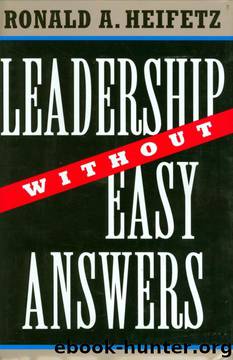Leadership Without Easy Answers by Ronald A. Heifetz

Author:Ronald A. Heifetz
Language: eng
Format: mobi
Published: 2009-09-06T18:18:00+00:00
The framers of the Constitution had in mind the transformation of executive authority from an imperial monarchy to a constrained presidency. By forcing the President to share powers with the legislature and the courts and by rendering his officeholding contingent on public opinion, they intended to force his attention to the views of others. Presidential action, it was hoped, would pay high regard in its synthesis to the conflicting values, priorities, beliefs, and behaviors of a diverse nation facing adaptive hurdles everyday.
In a sense, the presidency as an institution embodied a revolutionary conception of executive leadership. And no wonder; it emerged from the antiauthoritarian sentiment of the new and rebellious nation. No longer were people to look up to the solitary silverbackthe monarch-for decisive answers to the problems of direction, protection, orientation, conflict, and the care of norms. The colonists had grown tired of being misled by rulers whose visions came from within. They wanted public officials whose visions were derived or shaped from without. Presidential perspectives had to be realitytested against a multiplicity of views. Presidential action would require collaboration.
Ironically, with the emergence of America's dominant role in twentieth-century world affairs and the domestic stresses generated by that role, the presidency reverted, in varying degrees, to the imperial mode."0 Under the Cold War pressures to provide a more traditional kind of leadership, Truman, Eisenhower, and Kennedy took on more autocratic styles of behavior in foreign policy.' Congress and the public as a whole expected technical expertise and autocratic policymaking in the guise of leadership, and that is what they got. In a time of prolonged distress, our gaze became fastened on authority, shaping both the actions and selection of Presidents. By the time Johnson and Nixon came on the scene, the stage was set for tragedy.
The Constitutional design for presidential leadership seemed eminently suited to a nation facing adaptive work, yet the renewal of that design now became in its own right an adaptive challenge. Following Watergate, Jimmy Carter tried, in some ways, to meet that challenge. His presidency offers a complex picture of an authority still operating too much like the technician, yet trying to move toward a more honest encounter with the public.
On one hand, Jimmy Carter saw himself as the provider of wellengineered policy answers. His very education as an engineer may have left him ill-prepared to understand the adaptive requirements of policies, and therefore the need for collaboration and pacing. Having campaigned for President as an anti-Washington outsider, he began and remained a President with a weak set of relationships with members of Congress. He did not understand their role in public problem-solving or their ways. In his first months in the White House, he launched a slew of major policy initiatives toward a Congress not eager, after Watergate, to take orders from anybody, and ill-equipped to digest so much so fast."Z
On the other hand, Carter tried, without great skill but courageously, to challenge the nation to face problems of both values and habits. On July 15, 1979, during the revolution in Iran, he gave his address on oil policy.
Download
This site does not store any files on its server. We only index and link to content provided by other sites. Please contact the content providers to delete copyright contents if any and email us, we'll remove relevant links or contents immediately.
International Integration of the Brazilian Economy by Elias C. Grivoyannis(75876)
The Radium Girls by Kate Moore(11641)
Turbulence by E. J. Noyes(7720)
Nudge - Improving Decisions about Health, Wealth, and Happiness by Thaler Sunstein(7262)
The Black Swan by Nassim Nicholas Taleb(6786)
Rich Dad Poor Dad by Robert T. Kiyosaki(6196)
Pioneering Portfolio Management by David F. Swensen(6092)
Man-made Catastrophes and Risk Information Concealment by Dmitry Chernov & Didier Sornette(5674)
Zero to One by Peter Thiel(5507)
Secrecy World by Jake Bernstein(4407)
Millionaire: The Philanderer, Gambler, and Duelist Who Invented Modern Finance by Janet Gleeson(4117)
The Age of Surveillance Capitalism by Shoshana Zuboff(4001)
Skin in the Game by Nassim Nicholas Taleb(3982)
The Money Culture by Michael Lewis(3860)
Bullshit Jobs by David Graeber(3851)
Skin in the Game: Hidden Asymmetries in Daily Life by Nassim Nicholas Taleb(3739)
The Dhandho Investor by Mohnish Pabrai(3574)
The Wisdom of Finance by Mihir Desai(3539)
Blockchain Basics by Daniel Drescher(3343)
